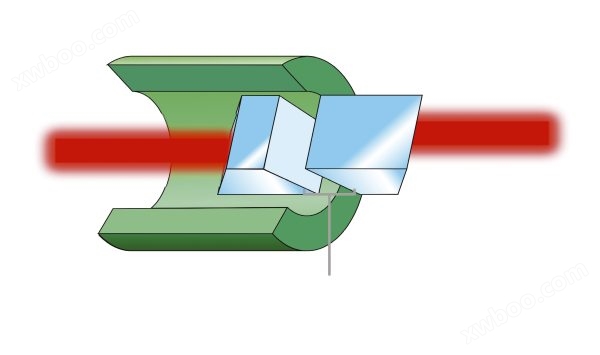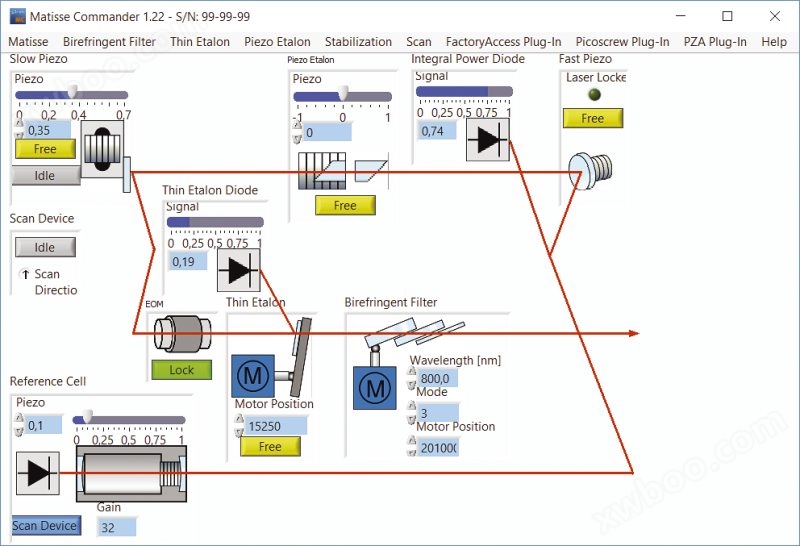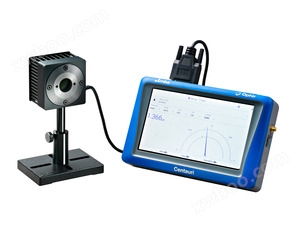品牌
生产厂家厂商性质
所在地
| Matisse 2 TR | Matisse 2 TS | Matisse 2 TX-light | Matisse 2 TX | Matisse 2 DR | Matisse 2 DS | Matisse 2 DX | |
|---|---|---|---|---|---|---|---|
| 激光增益介质 | Ti:Sapphire | Ti:Sapphire | Ti:Sapphire | Ti:Sapphire | Dye | Dye | Dye |
| 线宽5 | <4 MHz rms | <50 kHz rms6 | <50 kHz rms6 | <30 kHz rms6 | <20 MHz rms6 | <200 kHz rms6 | <100 kHz rms6 |
| 空间模式 | TEM00 | TEM00 | |||||
| 光束直径2 | 1.4 mm (典型值) | 1.4 mm (典型值) | |||||
| 光束发散角7 | <1 mrad | <1 mrad | |||||
| 振幅噪声 | <0.1% rms (泵噪声之上,正交增加) | <0.5% rms | |||||
| 扫描范围 | >50 GHz (@ 780 nm) | >60 GHz (@ 575 nm) | |||||
| Matisse 2 TR | Matisse 2 TS | Matisse 2 TX-light | Matisse 2 TX | Matisse 2 DR | Matisse 2 DS | Matisse 2 DX | |
|---|---|---|---|---|---|---|---|
| MOS-1 光学组件 | 680-790 nm | 680-790 nm | 680-790 nm | 690-770 nm | - | ||
| MOS-2 光学组件 | 750-870 nm | 750-870 nm | 750-870 nm | 750-870 nm | - | ||
| MOS-2-BB 光学组件 | 730-930 nm | 730-930 nm | 730-930 nm | 730-930 nm | - | ||
| MOS-3 光学组件 | 880-1038 nm | 880-1038 nm | 880-1038 nm | 880-1010 nm | - | ||
| MOS-4 光学组件 | - | 550-660 nm | 550-660 nm | 550-660 nm | |||
| MOS-5 光学组件 | - | 650-760 nm | 650-760 nm | 650-760 nm | |||
| Matisse 2 TR | Matisse 2 TS | Matisse 2 TX-light | Matisse 2 TX | Matisse 2 DR | Matisse 2 DS | Matisse 2 DX | |
|---|---|---|---|---|---|---|---|
| Millennia eV 25 W 泵 | 7.2 W | 6.2 W | 6.0 W | 4.5 W | |||
| Millennia eV 20 W 泵 | 5.5 W | 4.7 W | 4.5 W | 3.4 W | |||
| Millennia eV 15 W 泵 | 3.8 W | 3.3 W | 3.0 W | 2.2 W | |||
| Millennia eV 10 W 泵 | 2.0 W | 1.6 W | 1.8 W | 1.4 W | |||
| Millennia eV 5 W 泵 | 0.8 W | 不适用 | 0.8 W | 不适用 | |||
| Matisse 2 TR | Matisse 2 TS | Matisse 2 TX-light | Matisse 2 TX | Matisse 2 DR | Matisse 2 DS | Matisse 2 DX | |
|---|---|---|---|---|---|---|---|
| 泵激光偏振 | 水平 | ||||||
| 泵激光器功率 | 5-25 W | ||||||
| 环境条件 | ±0.5°C @ 20-25°C, 非冷凝湿度条件 | ||||||
| 冷却 | 从晶体去除 20 W 的热量所需的水;推荐与 Millennia 冷却装置串联; 建议 16–21°C 范围内变化 ±0.1°C 染料型号: 从染料循环器去除 100 W 热量所需的水 | ||||||
| 实验室 | 振动隔离光学台、无尘空气 (流动箱) | ||||||
| 电气特性 | 100-250 VAC, max 2.5 A | ||||||
| 计算机控制 | Windows 操作系统 | ||||||
注释:

The Out of Plane cavity design is a stable and more reliable configuration delivering years of worry free operation. All CW ring lasers support uni-directional propagation of light within the laser cavity. Most ring lasers utilize a thin intracavity waveplate which is easily damaged, resulting in lower output power and performance. The Matisse lasers are configured with an Out of Plane cavity design eliminating the need for this thin waveplate.
The Matisse is available with three levels of frequency stabilization: Passive stabilization with phase lock loop, active stabilization with reference cell, and active stabilization with Pound-Drever-Hall locking for ultranarrow linewidths to <30 KHz (100 ms integration time).
Superior mechanical stability, specially designed optical mounts, unique tuning methods, and the preferred Out of Plane cavity design of the Matisse C all contribute to the exceptional mode-hop-free scanning range of >50 GHz. In order to take this to the next level, we have developed “Scan Stitching” for wide mode-hop-free tuning over the full wavelength range (up to 300 nm).
Even the smallest tilts in linear travel when wavelength tuning by changing the cavity length of a ring laser will result in decreased output power. All optics meant to travel linearly in the Matisse are mounted on flexure optical mounts. These mounts enlarge the scan range and guides linear translation, therefore providing power flatness to within 5% across 50 GHz of mode-hop-free tuning.

The Millennia eV platform is based on Spectra-Physics’ It’s in the Box™ design, where the laser optical cavity, diode and control electronics are all integrated in a single, compact package, eliminating the need for an external power supply. With its industry leading scalability from 5 W to 25 W average power and high reliability, Millennia eV is the next generation laser of choice for demanding scientific applications such as the pumping of CW Ti:Sapphire lasers.

The unique cavity design of the Matisse incorporates two etalons. The second etalon provides increased long term mode stability. This “thick etalon” uses air gap technology for maximum locking stability.

CW single frequency ring lasers utilize a Phase Lock Loop (PLL) in order to stabilize the laser cavity to a single longitudinal mode. The Matisse incorporates a unique PLL technique that delivers low dither frequencies (down to 500 Hz) to minimize laser noise and allows easy adjustability of the frequency (500 Hz – 3 kHz) via software.
The Matisse can counteract the wavelength drift which is specific to any tunable CW single mode laser. To further counteract drift for a Matisse without reference cavity, a good wavemeter can be used as reference. Or for a Matisse laser with reference cavity an optional strain gauge can be installed on the scanning piezo. It is also possible to use the Matisse reference cavity as a transfer cavity or to stabilize it to an atomic resonance or a frequency comb.

Matisse 2 R 系列环形腔激光器采用机械*设计,可实现的被动稳定性以及超低噪音的单频运行。Matisse 2 R 系列环形腔激光器采用机械*设计,可实现的被动稳定性以及超低噪音的单频运行。电子力驱动的波长选择元件 - 双折射滤光器、厚校准器和薄校准器 - 使激光器在单纵模上保持居中。这样可实现很长的无跳模波长扫描,同时保持恒定的低噪音输出功率水平。
Matisse 2 TR 钛宝石环形激光器提供 <4 MHz 光谱线宽,并且可以很容易地升级为更高分辨率的 Matisse 2 TS。实际上,由于其模块性,任何 Matisse 2 激光器都可现场升级为钛宝石或染料增益介质,或者升级为更高分辨率的配置,即从 R 系列升级为 S 系列或 X 系列。
Matisse 2 S 系列主动稳定性环形腔激光器采用外部参考腔体,可对腔长度稳定化的快速压电驱动反射镜进行反馈。为保证真正独立的频率反馈信号,参考腔体与热和机械扰动*隔离,并在激光器外壳外部进行光纤耦合。Matisse 2 TS 主动稳定性钛宝石环形腔激光器具有 <50 kHz 内部光谱线宽,而 Matisse 2 DS 染料环形激光器提供 <250 kHz 光谱线宽。
Matisse 2 X 系列环形腔激光器为钛宝石主动增益介质提供低于 30 kHz 光谱线宽,为染料激光器提供 100 kHz 光谱线宽。这种超窄线宽是极快的腔长度稳定化与 MHz 级响应带宽相结合的产物。腔内电光调制器 (EOM) 的使用让这种超窄线宽得以实现。
实现这种超窄线宽的另一个关键是来自采用 Pound-Drever-Hall 稳定化方案的外部参考腔体以及高精度外部参考腔体的反馈误差信号。Pound-Drever-Hall 提供准确的不受激光强度波动影响的波长位置测量。
Matisse 2 TX-light Matisse 2 TS 与 Matisse 2 TX 之间的线宽空白。它利用 Pound-Drever-Hall 锁定技术和 TX 的高分辨率参考腔体,向 TS 的快速压电驱动反射镜提供反馈信号。Pound-Drever-Hall 方法可以忽略对强度波动的敏感性,再加上它提供的极其稳定的锁定技术,造就了低于 60 kHz 的激光线宽。
要验证和分析 Matisse 2 激光器的输出功率,我们推荐使用 Ophir 10A (7Z02637) 热功率传感器和 Centauri 激光功率计。 有关此激光测量设备的更多信息,请访问 网站。 其他 Ophir 传感器和仪表也可能适用于 Matisse 2,详细情况取决于具体应用。 Ophir 还与激光系统开发人员合作,实现嵌入式光束诊断,提供了监控系统性能的 OEM 解决方案。
